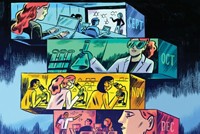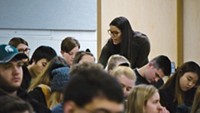Advertisement
Grab your lab coat. Let's get started
Welcome!
Welcome!
Create an account below to get 6 C&EN articles per month, receive newsletters and more - all free.
It seems this is your first time logging in online. Please enter the following information to continue.
As an ACS member you automatically get access to this site. All we need is few more details to create your reading experience.
Not you? Sign in with a different account.
Not you? Sign in with a different account.
ERROR 1
ERROR 1
ERROR 2
ERROR 2
ERROR 2
ERROR 2
ERROR 2
Password and Confirm password must match.
If you have an ACS member number, please enter it here so we can link this account to your membership. (optional)
ERROR 2
ACS values your privacy. By submitting your information, you are gaining access to C&EN and subscribing to our weekly newsletter. We use the information you provide to make your reading experience better, and we will never sell your data to third party members.
Education
Revising The Chemistry Curriculum
Chemistry departments take an integrated approach to the traditional subdisciplines
by Celia Henry Arnaud
March 2, 2015
| A version of this story appeared in
Volume 93, Issue 9

The traditional chemistry curriculum divides the discipline into isolated slices. Students typically take a two-semester sequence in each of the subdisciplines—organic, inorganic, physical, analytical, and biochemistry. Sometimes students struggle to see how the pieces fit together. So some schools are revising their curricula to present chemistry as a more integrated whole.
One such example is the College of Saint Benedict and Saint John’s University—a pair of liberal arts colleges in Minnesota with a shared faculty that caters to women and men, respectively. The chemistry faculty had long talked of their desire to revamp the curriculum. But the talk was just talk because they needed to maintain a curriculum approved by the American Chemical Society. Then, in 2008, ACS revised its Guidelines for Bachelor’s Degree Programs, and everything changed.
The revisions gave chemistry departments the flexibility to move away from the conventional silos. Departments were free to offer courses that integrate the chemical subdisciplines, as long as the new curriculum included the equivalent of a foundational course in each of the subdisciplines plus at least four in-depth courses.
When the faculty at Saint Benedict and Saint John’s built a new curriculum from the ground up, they integrated the subdisciplines in a series of classes organized around the pillars of structure, reactivity, and quantification. The department has rolled out the new classes over the past several years; this year’s graduating class is the first cohort to experience the new curriculum from start to finish.
The sequence starts with an introduction to structure and chemical properties. The class focuses on the structure of ionic solids, metals, organic molecules, and biological molecules. Students even learn conformational analysis.
After structure, the students move to three semesters of reactivity. The three classes take a mechanistic approach to underscore the commonalities among organic, inorganic, and biochemical reactions. The first class focuses on carbonyl and coordination chemistry to increase its relevance for biology and premed students. “The goal was to develop the chemistry needed to understand biochemical pathways,” says Kate Graham, a professor in the department.
The second course casts a wider net, including topics such as substitution, addition, and elimination reactions using examples from organic, inorganic, and biochemistry. Reactivity III, primarily taken by those planning to major in chemistry or biochemistry, focuses on single-electron chemistry, “everything from redox chemistry and redox potentials to photochemistry,” says Chris P. Schaller, another professor in the department. By the end of the three-semester sequence, students have taken the equivalent of a foundation course in each of the organic, inorganic, and biochemistry subdisciplines.
The other two foundation courses take a mathematical approach to chemistry. “We try to deal with conceptual issues before we get to the math,” says Brian Johnson, a chemistry professor.
These two classes combine physical and analytical chemistry to address analysis of matter from the macroscopic level to that of single molecules. Students learn about thermodynamics and equilibrium in the first class and about quantum mechanics in the second class. “We use mathematical tools a little bit all the way through,” Schaller says. “But this is where the students get to be experts with working with numbers and understanding what the math is really all about.”
After the foundation courses, the students choose at least three among 18 half-semester in-depth special topics courses. Students who want to receive the ACS-certified degree must take at least six of the special topics classes. By taking prescribed sets of classes, students can concentrate in chemical biology, environmental chemistry, or materials/industrial chemistry.
The laboratory portion of the curriculum is separate from the classroom courses. The sequence consists of two semesters of purification lab, one semester of synthesis, and one semester of quantitative measurement. Chemistry majors then take an integrated lab and carry out a research project.
Saint Benedict and Saint John’s are not the only ones that are revamping their chemistry curriculum. At Emory University, the faculty are undertaking a similar ground-up revision that they expect to roll out in fall 2016.
The Emory revision is still in early days. “We have a strong plan for the first five courses,” says Patricia Marsteller, director of Emory’s Center for Science Education and the principal investigator on a grant from Howard Hughes Medical Institute that is underwriting development of the new curriculum. “We’ll place chemistry concepts in the context of current research and real-world problems.”
Emory students will first take an introductory class called Engagement with Modern Chemistry. After that, students will take a set of four foundation courses. Those four courses cover organic, inorganic, physical, and biochemistry, but they do so in the context of a particular theme. For example, the physical chemistry class will be organized around the theme of energy landscapes, Marsteller says. The courses are designed to be taken in any order, so students are free to choose the order that best suits their interests.
Part of the plan is to prepare students to jump into undergraduate research earlier. In the old curriculum, “by the time students wanted to get into a research lab, they’d only seen general and organic,” says Douglas Mulford, director of undergraduate studies in the Emory chemistry department. “They had no training in bio, no training in inorganic, no training in physical. They couldn’t be pulled into research labs because they hadn’t seen those areas. We want them to be exposed to all of the areas early.”
Development of Emory’s new upper-level courses has not progressed as far. The real work on those classes will happen in the 2015–16 academic year. “We should be able to start rolling them out the following year,” Marsteller says.
At Saint Benedict and Saint John’s, the new curriculum has coincided with rapid growth in the number of chemistry and biochemistry majors. For decades, the colleges have had between 18 and 24 chemistry and biochemistry majors each year. That number has nearly doubled. About 35 students are on track to graduate this year. In addition, an average of 47 students per year have applied to the majors as sophomores in the past two years. Graham suspects that some of the uptick is attributable to the new curriculum retaining chemistry majors who in earlier days might have switched to biology.
The new curricula may give students a truer picture of science. “Our curriculum is much more in line with what science is and looks like philosophically,” says T. Nicholas Jones, a professor at Saint Benedict and Saint John’s. “Very few people are solely inorganic or organic or biochemists. You have to be fluent across the boundaries.”





Join the conversation
Contact the reporter
Submit a Letter to the Editor for publication
Engage with us on Twitter